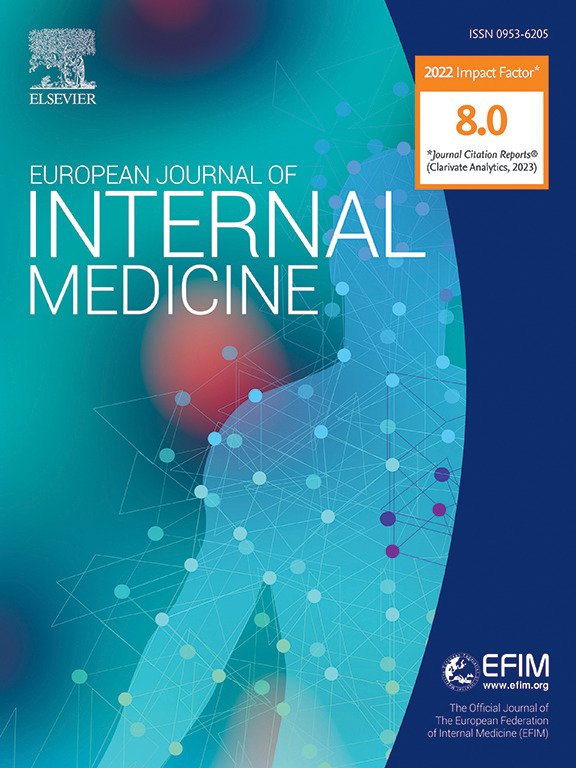缬沙坦与氨氯地平及降压对终末期肾病发病率的影响:VALUE试验
IF 5.9
2区 医学
Q1 MEDICINE, GENERAL & INTERNAL
引用次数: 0
摘要
背景:关于降压药物类别和血压(BP)治疗靶点对终末期肾病(ESKD)发病率影响的研究数据缺乏。在50-80岁及以上的高危高血压患者中,我们的目的是:1)比较血管紧张素受体阻滞剂缬沙坦与钙通道阻滞剂氨氯地平的效果;2)评估达到收缩压的效果。VALUE试验是一项多中心前瞻性双盲随机临床试验,在原发性高血压和高危心血管疾病患者中进行,包括已知的冠状动脉疾病、左心室肥厚和既往卒中,ESKD是次要终点,定义为肾移植和/或透析进展。患者被随机分配到缬沙坦或氨氯地平,如果需要达到收缩压目标,其他抗高血压药物作为附加药物。结果:15,245例患者被随机分配并随访至63,631例患者-年,只有90例患者失去随访。缬沙坦和氨氯地平的主要结局是心脏发病率和死亡率的综合指标。缬沙坦组47例(0.61%),氨氯地平组50例(0.66%)发生ESKD (HR=1.02, 95% CI 0.68-1.52, p =0.94)。结论:在心血管高危高血压患者中,缬沙坦与氨氯地平对终末期肾病的发生率影响相似。实现SBP本文章由计算机程序翻译,如有差异,请以英文原文为准。

Effects of valsartan vs amlodipine and achieved lower blood pressure on the incidence of end-stage kidney disease: The VALUE Trial
Background
There is a paucity of data investigating the impact of antihypertensive drug classes and blood pressure (BP) treatment targets on the incidence of end-stage kidney disease (ESKD). In patients with high-risk hypertension aged 50–80 years or above, we aimed to, 1) compare effects of valsartan, an angiotensin receptor blocker, with amlodipine, a calcium channel blocker and, 2) assess the effect of achieving systolic BP <135 vs ≥135 mmHg on the ESKD incidence.
Methods
The VALUE Trial was a multicenter prospective double-blinded randomized clinical trial in patients with essential hypertension and high cardiovascular risk including known coronary disease, left ventricular hypertrophy and previous stroke, in which ESKD was a secondary endpoint defined as progression to kidney transplant and/or dialysis. Patients were randomized to either valsartan or amlodipine, with other anti-hypertensive medications as add-on if needed to reach the systolic BP target of <140 mmHg. Cox proportional hazards ratio (HR) was used to compare different treatment groups and achieved systolic BP <135 with ≥135 mmHg, during 3–6 years of follow-up.
Results
15,245 patients were randomized and followed until 63,631 patient-years with only 90 patients lost to follow-up. The primary outcome, a composite of cardiac morbidity and mortality, was neutral between valsartan and amlodipine. On valsartan 47 patients (0.61 %) and on amlodipine 50 patients (0.66 %) developed ESKD (HR=1.02, 95 % CI 0.68–1.52, p =0.94). Achieved SBP <135 mmHg was strongly related to less ESKD (n =9/5036 patients, 0.2 %) compared with achieved SBP ≥135 mmHg (n =73/8766 patients, 0.8 %) (HR=0.28, CI 0.14–0.58, p <0.001).
Conclusions
In hypertensive patients with a high cardiovascular risk, valsartan and amlodipine have a similar impact on the incidence of end-stage kidney disease. Achieving SBP <135 mmHg, averaging 128.8/77.3 mmHg, is highly efficacious in kidney protection.
求助全文
通过发布文献求助,成功后即可免费获取论文全文。
去求助
来源期刊
CiteScore
9.60
自引率
6.20%
发文量
364
审稿时长
20 days
期刊介绍:
The European Journal of Internal Medicine serves as the official journal of the European Federation of Internal Medicine and is the primary scientific reference for European academic and non-academic internists. It is dedicated to advancing science and practice in internal medicine across Europe. The journal publishes original articles, editorials, reviews, internal medicine flashcards, and other relevant information in the field. Both translational medicine and clinical studies are emphasized. EJIM aspires to be a leading platform for excellent clinical studies, with a focus on enhancing the quality of healthcare in European hospitals.

 求助内容:
求助内容: 应助结果提醒方式:
应助结果提醒方式:


